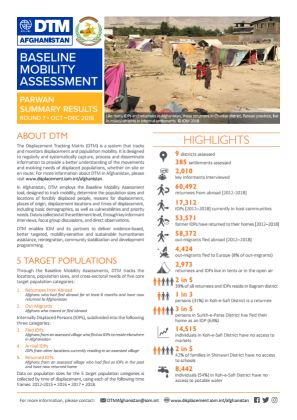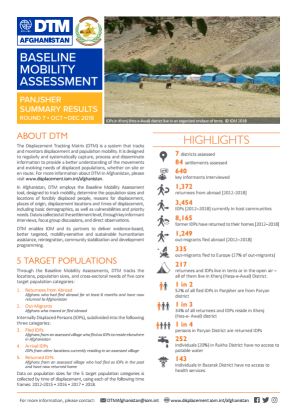-
Countries
-
Data and Analysis
-
Special Focus
-
Crisis Responses
Return migration

Contact
DTMAfghanistan@iom.int
Language
English
Location
Afghanistan
Period Covered
Oct 01 2018
Dec 31 2018
Activity
- Mobility Tracking
- Baseline Assessment
In Afghanistan, DTM employs the Baseline Mobility Assessment tool, designed to track mobility, determine the population sizes, locations and geographic distribution of forcibly displaced, return and migrant populations, reasons for displacement, places of origin, and times of displacement, as well as basic demographics, vulnerabilities and priority needs. Data is collected at the settlement level, through community focus group discussions with key informants and direct observations.
This provincial report summarises the DTM findings in Wardak. The data has been collected throughout 9 districts and 212 settlements in Wardak.

Contact
DTMAfghanistan@iom.int
Language
English
Location
Afghanistan
Period Covered
Oct 01 2018
Dec 31 2018
Activity
- Mobility Tracking
- Baseline Assessment
In Afghanistan, DTM employs the Baseline Mobility Assessment tool, designed to track mobility, determine the population sizes, locations and geographic distribution of forcibly displaced, return and migrant populations, reasons for displacement, places of origin, and times of displacement, as well as basic demographics, vulnerabilities and priority needs. Data is collected at the settlement level, through community focus group discussions with key informants and direct observations.
This provincial report summarises the DTM findings in Uruzgan. The data has been collected throughout 5 districts and 98 settlements in Uruzgan.

Contact
DTMAfghanistan@iom.int
Language
English
Location
Afghanistan
Period Covered
Oct 01 2018
Dec 31 2018
Activity
- Mobility Tracking
- Baseline Assessment
In Afghanistan, DTM employs the Baseline Mobility Assessment tool, designed to track mobility, determine the population sizes, locations and geographic distribution of forcibly displaced, return and migrant populations, reasons for displacement, places of origin, and times of displacement, as well as basic demographics, vulnerabilities and priority needs. Data is collected at the settlement level, through community focus group discussions with key informants and direct observations.
This provincial report summarises the DTM findings in Takhar. The data has been collected throughout 16 districts and 485 settlements in Takhar.

Contact
DTMAfghanistan@iom.int
Language
English
Location
Afghanistan
Period Covered
Oct 01 2018
Dec 31 2018
Activity
- Mobility Tracking
- Baseline Assessment
In Afghanistan, DTM employs the Baseline Mobility Assessment tool, designed to track mobility, determine the population sizes, locations and geographic distribution of forcibly displaced, return and migrant populations, reasons for displacement, places of origin, and times of displacement, as well as basic demographics, vulnerabilities and priority needs. Data is collected at the settlement level, through community focus group discussions with key informants and direct observations.
This provincial report summarises the DTM findings in Sar-e-Pul. The data has been collected throughout 7 districts and 234 settlements in Sar-e-Pul.

Contact
DTMAfghanistan@iom.int
Language
English
Location
Afghanistan
Period Covered
Oct 01 2018
Dec 31 2018
Activity
- Mobility Tracking
- Baseline Assessment
In Afghanistan, DTM employs the Baseline Mobility Assessment tool, designed to track mobility, determine the population sizes, locations and geographic distribution of forcibly displaced, return and migrant populations, reasons for displacement, places of origin, and times of displacement, as well as basic demographics, vulnerabilities and priority needs. Data is collected at the settlement level, through community focus group discussions with key informants and direct observations.
This provincial report summarises the DTM findings in Samangan. The data has been collected throughout 7 districts and 209 settlements in Samangan.

Contact
DTMAfghanistan@iom.int
Language
English
Location
Afghanistan
Period Covered
Oct 01 2018
Dec 31 2018
Activity
- Mobility Tracking
- Baseline Assessment
In Afghanistan, DTM employs the Baseline Mobility Assessment tool, designed to track mobility, determine the population sizes, locations and geographic distribution of forcibly displaced, return and migrant populations, reasons for displacement, places of origin, and times of displacement, as well as basic demographics, vulnerabilities and priority needs. Data is collected at the settlement level, through community focus group discussions with key informants and direct observations.
This provincial report summarises the DTM findings in Parwan. The data has been collected throughout 9 districts and 385 settlements in Parwan.

Contact
DTMAfghanistan@iom.int
Language
English
Location
Afghanistan
Period Covered
Oct 01 2018
Dec 31 2018
Activity
- Mobility Tracking
- Baseline Assessment
In Afghanistan, DTM employs the Baseline Mobility Assessment tool, designed to track mobility, determine the population sizes, locations and geographic distribution of forcibly displaced, return and migrant populations, reasons for displacement, places of origin, and times of displacement, as well as basic demographics, vulnerabilities and priority needs. Data is collected at the settlement level, through community focus group discussions with key informants and direct observations.
This provincial report summarises the DTM findings in Panjsher. The data has been collected throughout 7 districts and 84 settlements in Panjsher.

Contact
DTMAfghanistan@iom.int
Language
English
Location
Afghanistan
Period Covered
Oct 01 2018
Dec 31 2018
Activity
- Mobility Tracking
- Baseline Assessment
In Afghanistan, DTM employs the Baseline Mobility Assessment tool, designed to track mobility, determine the population sizes, locations and geographic distribution of forcibly displaced, return and migrant populations, reasons for displacement, places of origin, and times of displacement, as well as basic demographics, vulnerabilities and priority needs. Data is collected at the settlement level, through community focus group discussions with key informants and direct observations.
This provincial report summarises the DTM findings in Paktya. The data has been collected throughout 11 districts and 405 settlements in Paktya.

Contact
DTMAfghanistan@iom.int
Language
English
Location
Afghanistan
Period Covered
Oct 01 2018
Dec 31 2018
Activity
- Mobility Tracking
- Baseline Assessment
In Afghanistan, DTM employs the Baseline Mobility Assessment tool, designed to track mobility, determine the population sizes, locations and geographic distribution of forcibly displaced, return and migrant populations, reasons for displacement, places of origin, and times of displacement, as well as basic demographics, vulnerabilities and priority needs. Data is collected at the settlement level, through community focus group discussions with key informants and direct observations.
This provincial report summarises the DTM findings in Paktika. The data has been collected throughout 19 districts and 266 settlements in Paktika.

Contact
DTMAfghanistan@iom.int
Language
English
Location
Afghanistan
Period Covered
Oct 01 2018
Dec 31 2018
Activity
- Mobility Tracking
- Baseline Assessment
In Afghanistan, DTM employs the Baseline Mobility Assessment tool, designed to track mobility, determine the population sizes, locations and geographic distribution of forcibly displaced, return and migrant populations, reasons for displacement, places of origin, and times of displacement, as well as basic demographics, vulnerabilities and priority needs. Data is collected at the settlement level, through community focus group discussions with key informants and direct observations.
This provincial report summarises the DTM findings in Nuristan. The data has been collected throughout 8 districts and 47 settlements in Nuristan.
Pagination
- Previous page
- Page 42
- Next page
